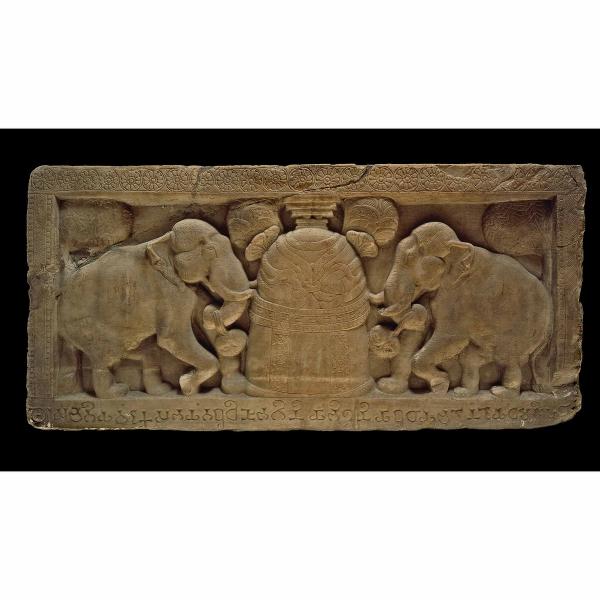Pillar abacus: elephants venerating the Rāmagrāma stupa
Artwork Details
- Title: Pillar abacus: elephants venerating the Rāmagrāma stupa
- Period: Satavahana
- Date: late 1st century CE
- Culture: India, Amaravati Great Stupa, Guntur district, Andhra Pradesh
- Medium: Limestone
- Dimensions: H. 12 13/16 in. (32.5 cm); W. 25 3/4 in. (68 cm); D. 16 9/16 in. (42 cm)
Display module with collar: H. 22 1/2 in. (54 cm); W. 33 1/4 in. (84.5 in.) D. 21 1/3 in. (54 cm) - Classification: Sculpture
- Credit Line: Lent by British Museum, London
- Rights and Reproduction: © The Trustees of the British Museum
- Curatorial Department: Asian Art
Audio

675. Elephants Venerating the Rāmagrāma Stupa
DONALD LOPEZ: As the Buddha was about to die, he instructed his monks to cremate him and to then take his ashes and bury them in a mound. And the term that was used for this mound was a stupa.
My name is Donald Lopez. I’m a professor of Buddhist and Tibetan studies at the University of Michigan.
NARRATOR: The relics containing the Buddha’s remains were divided into eight shares. One of those was placed in a stupa in a city called Ramagrama. The front panel here tells us a story related to that division of relics.
DONALD LOPEZ: We have on the right, two elephants worshiping a stupa.And on the left we have a Yaksha, a local god of ancient India, who is seen here as a protector.
NARRATOR: Legend proclaimed that the stupa had fallen into the bottom of the river and that it was protected by Nagas, the mystical snakes we see represented throughout this exhibition. However, we learn a different story from a historical account from a Chinese pilgrim in the early fifth century CE called Faxian.
DONALD LOPEZ: He wanted to go and visit these various stupas. When he got to Ramagrama, he found that this stupa was not under water, it was on the edge of the river, and it was deserted. There were no monks there, there was no one there to worship it.There were just a herd of elephants present.
The elephants would offer flowers to the stupa, and they would wash it with their trunks, and so this is depicting those elephants worshiping at the stupa at Ramagrama, which contains the relics of the Buddha. The Buddha had a very close relationship with elephants. They liked him, he liked them. And so, this is a very nice depiction of their devotion to the Buddha even after his passing.
The elephants here unlike in Faxian’s description are not simply washing the stupa or offering flowers, but they are actually bowing to the Buddha lowering down on one knee to show their reverence to him and to his memory.